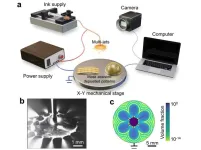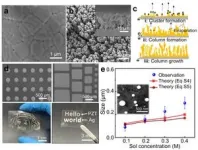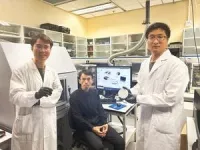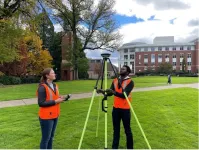(Press-News.org)
A research team led by The Hong Kong University of Science and Technology (HKUST) has developed a microprinter that can print piezoelectric films 100 times faster for the production of microelectromechanical systems (MEMS) for sensors, wearable or implantable medical devices, offering the possibility to lower the mass production costs.
The microprinter, built at a comparatively lower cost as compared with other printers on the market, utilizes an electrostatic field to propel streams of ink onto a platform, allowing for efficient manipulation of thin film patterns and enhanced printing speed to address the challenge of mass production and control of structures and feature sizes.
Nanoparticles, films, and patterns are three critical piezoelectric elements with widespread applications in sensing, actuation, catalysis, and energy harvesting. Mass Production of these elements remains a challenge to date as exerting control of these structures and feature sizes on various substrates is a complicated process. Amidst of the ongoing surge in demand for MEMS, wearable/implantable electronics, miniaturized portable devices, and the Internet of Things, the pursuit of piezoelectric materials, thanks to their intrinsical property of coupling mechanical and electrical energy, has become a priority and interest for many.
Until recently, the novel microprinter developed by the HKUST research team has represented a significant step toward ultrafast and large-area additive micromanufacturing of 3D objects with virtually any composition and adjusted microstructure and functionality.
In their experiment, the team led by Prof. YANG Zhengbao, Associated Professor at the Department of Mechanical & Aerospace Engineering at HKUST, constructed a 3D microprinting mechanism utilizing a spiny disc connected to a needle and a power supply. Once the team creates an electrostatic field that is powerful enough to serve as a propellant, streams of ink would then be cone-jetting onto a platform, forming micro patterns just like how streams of charged droplets are ejected from the tips of raindrops in a thunderstorm.
Through the efforts of the team, the manufacturing speed has been enhanced by a factor of 100, allowing for efficient manipulation of thin film patterns similar to semiconductor lithography. For instance, a 10 μm-thick PZT film on a 4-inch Si wafer can be fabricated in just 10 minutes using the printer, with minimal material wastage. This breakthrough technique is applicable in manufacturing the piezoelectric component inside microphones, clinical ultrasound probes, and thin-film solar panels, with the expectation to reduce the production cost of related products.
“Our microprinter shows printing capability for wide-ranging classes of materials such as dielectric ceramic, metal nanoparticles, insulating polymers, and biological molecules,” Prof. YANG said. “It boasts the fastest speed in existing techniques for piezoelectric micrometer-thick films, and the PZT films we produced demonstrate excellent piezoelectric properties compared to current ones in the market. This new, affordable model of precision printing with features measurable at ~20 μm is surely going to bring benefits to many in the scientific world, and would lead to many breakthroughs that were previously thought impossible.”
Meanwhile, the microprinter has reached a stage where it is prepared for large-scale production, which costs only HKD 6,000, one of the lowest-cost options compared to others available on the market. The team is focused on integrating the printer with roll-to-roll substrate receiving systems to enable potential commercial applications. Additionally, they are actively seeking collaborations with commercial partners to enhance its market presence further.
“Current micromanufacturing technologies cannot achieve high-speed, versatile manufacturing of diversified piezoelectric elements and at the same time allow control of their dimensions, structures, and functionality,” added Prof. Yang. “Additionally, the cost and complexity of manufacturing equipment that enables fabricating micrometer features are prohibitive for large-scale production.”
This study is a collaborative work with City University of Hong Kong. Their findings were recently published in the journal Nature Communications. (https://doi.org/10.1038/s41467-023-42159-9).
END
CORVALLIS, Ore. – Oregon State University is one of four institutions selected to advance a federal effort to modernize the National Spatial Reference System, which underpins surveying, mapping, autonomous vehicle navigation, precision agriculture and the rest of the United States’ geospatial economy.
OSU will receive $6.5 million over five years from the National Oceanic and Atmospheric Administration for research to be conducted by the new Geospatial Center for the Arctic and Pacific, or GCAP. The funding is through NOAA’s National Geodetic Survey and is part of nearly $20 million awarded overall.
The other funding ...
Peer-reviewed/ review, analysis and opinion
The Lancet: Studying medicine, Nazism, and the Holocaust crucial to strengthening medical education and ethics today
Most comprehensive report to date on medical atrocities under Nazism and during the Holocaust – and their implications for today – details the central role health professionals played in formulating and carrying out the antisemitic, racist, and inhumane policies and practices during the Nazi regime.
The Commission challenges long-held misconceptions about medicine in the Nazi era, including the claim that medical crimes were carried out by only a ...
The effectiveness of live zoster (shingles) vaccine is highest in the first year after vaccination and then wanes substantially. But it continues to provide some protection against shingles and its complications ten years after vaccination, even in patients with a weakened immune system, finds a study published by The BMJ.
Vaccine effectiveness is a measure of how well vaccines work to protect communities in the real world.
Herpes zoster, commonly known as shingles, is a painful rash caused by reactivation of the chickenpox virus. It’s much more common among people aged 60 and older and those with a weakened ...
Lisbon, Portugal: Patients with HER2-positive breast cancer that has started to spread to other parts of the body survive for longer if they are treated with a new drug called pyrotinib, according to results from the longest follow-up of the PHOEBE randomised clinical trial in China.
Presenting the latest results at the Advanced Breast Cancer Seventh International Consensus Conference (ABC 7), Professor Xichun Hu, of Fudan University Cancer Hospital, Shanghai, China, said the researchers had been able to analyse data on overall survival from the trial up to March 15, ...
Some barnacles are ‘morphing’ to protect themselves from predatory warm-water sea snails, which are expanding into their territory due to climate change.
Research led by the University of Southampton and published in the Journal of Biogeography shows how temperate prey species are adapting to changing water temperatures, which carry the threat of warm-water predators encroaching into their territory.
As global sea-surface temperatures rise and the number of marine heatwaves increase under global heating, coastal marine communities are changing. Warm-water predators ...
AI can map giant icebergs from satellite images 10,000 times faster than humans
Scientists have trained an artificial intelligence (AI) system to accurately map - in one-hundredth of a second - the surface area and outline of giant icebergs captured on satellite images.
It is a major advance on existing automated systems which struggle to distinguish icebergs from other features in the image. Manual - or human - interpretation of the image is more ...
Whether talking about the office kitchen, hiking trails or ratings on Yelp, there are always people who put in effort to leave those spaces better. There are also those who contribute nothing to that public good.
New research using large-scale online experiments suggests that rewarding people to contribute to a virtual public good, such as a simulated online rating for a ferry system, increased the accuracy of the ratings and improved the overall quality of that resource.
The multidisciplinary team, including researchers from the University of California, Davis; Hunter College, College of New York; the Max Planck Institute for ...
1 in 25 carries a genotype that is associated with a shortened lifespan
Scientists at deCODE genetics, a subsidiary of Amgen, have published a study on actionable genotypes detected in the Icelandic population and their association with lifespan. The results of this study are among the things that have motivated the government of Iceland to announce a nationwide effort in precision medicine. As the delivery of precision medicine to a population requires considerable amount of data on genomics, transcriptomics and proteomics of the population, Icelanders are currently exceptionally well suited for ...
While we all aspire for a long lifespan, what is most coveted is a long period of vigor and health, or “healthspan,” that precedes the inevitable decline of advancing age. Researchers at UC Santa Barbara have discovered that instruments of death that cells use to commit suicide when things go wrong contribute to making a longer and healthier life by revitalizing the specialized cellular compartments called mitochondria.
Mitochondria generate the energy for all of our activities, from movement to thought. These power plants inside our cells descended ...
Dr. Vidhya Rangaraju has been named a recipient of the Chan Zuckerberg Initiative’s “Ben Barres Early Career Acceleration Award,” which will provide her lab with $1.2 million over four years to study dysfunctions of brain energy supply.
Dr. Rangaraju is a Research Group Leader at the Max Planck Florida Institute for Neuroscience (MPFI). With this award, her lab will investigate the causes of disrupted energy supply in neurons that lead to cognitive decline in amyotrophic lateral sclerosis (ALS). ...







